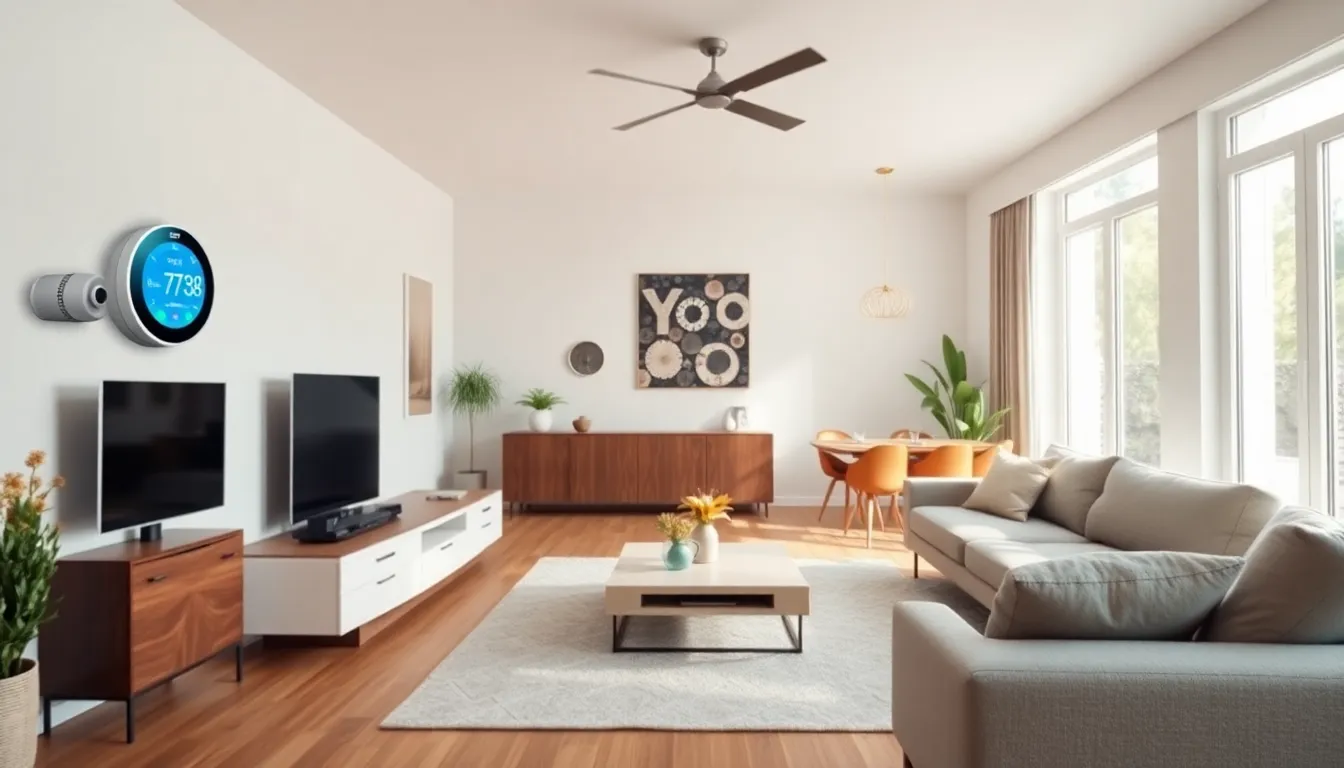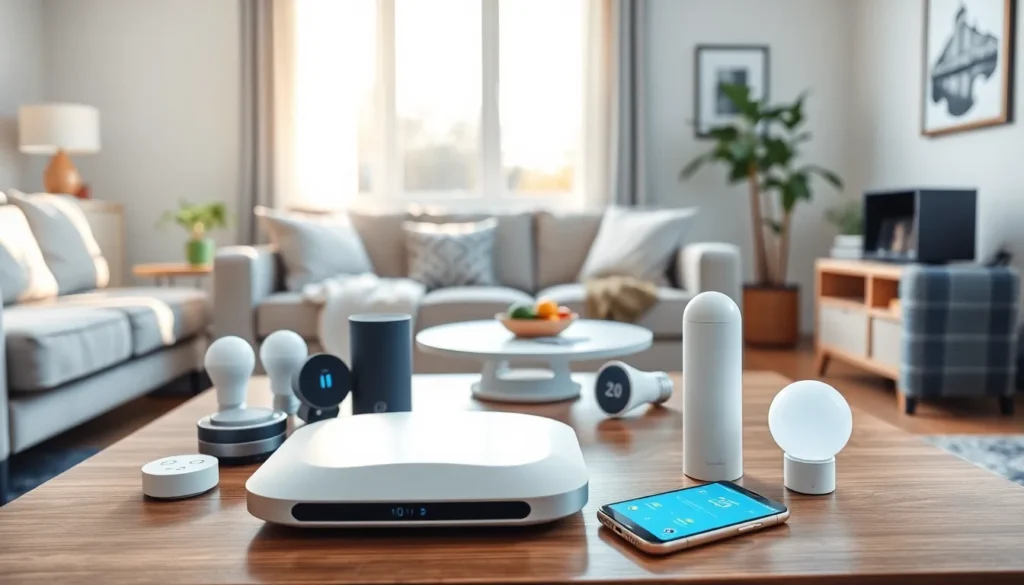Table of Contents
ToggleHome automation is transforming how people interact with their living spaces, making daily routines smoother and more efficient. At the heart of this technological revolution lies the home automation gateway, a crucial component that connects various smart devices and systems. This gateway acts as a central hub, enabling seamless communication between devices like smart lights, thermostats, and security cameras.
With the rise of the Internet of Things (IoT), homeowners are increasingly seeking ways to enhance convenience and security. A reliable home automation gateway not only streamlines device management but also allows for remote access and control, making it easier than ever to create a personalized smart home experience. As technology evolves, understanding the role of these gateways becomes essential for anyone looking to embrace the future of home automation.
Overview of Home Automation Gateway
A home automation gateway serves as a central hub within a smart home ecosystem. It connects various smart devices, enabling seamless communication between them. Many homes utilize these gateways to enhance convenience and optimize functionality across multiple platforms.
Home automation gateways facilitate device management by allowing users to control lights, thermostats, security cameras, and appliances from a single interface. This centralization simplifies operations and creates streamlined processes, reducing the complexity of managing individual devices.
Key features of home automation gateways include:
- Interoperability: A home automation gateway connects devices from various manufacturers. This ensures compatibility among different smart home products, regardless of brand.
- Remote Access: Users can control devices remotely via smartphones or tablets. This access promotes ease of use and provides security monitoring when away from home.
- Automation Capabilities: Customizable automation routines can be set up through the gateway. For instance, users may schedule lights to turn on at sunset or adjust thermostats based on occupancy.
- Integration with Voice Assistants: Many gateways integrate with voice assistants, allowing for voice-activated control. This feature enhances accessibility and user experience.
The home automation gateway acts as the backbone of a smart home, connecting devices to enhance convenience, security, and automation. Its capabilities make it vital for anyone looking to create a personalized, efficient living environment.
Key Features of Home Automation Gateways

Home automation gateways offer essential features that enhance the functionality of smart homes. Understanding these features helps users maximize the benefits of their automation systems.
Compatibility with Smart Devices
Compatibility with smart devices ensures seamless operation across various brands. Home automation gateways support multiple communication protocols, such as Zigbee, Z-Wave, and Wi-Fi. This interoperability allows users to connect devices from different manufacturers, enhancing versatility in building a smart home ecosystem. Users can easily integrate lighting systems, thermostats, security cameras, and more, creating a cohesive home automation experience.
Security Features
Security features play a critical role in home automation gateways. Robust encryption protocols protect data transmitted between devices. Many gateways offer two-factor authentication, preventing unauthorized access. Regular firmware updates also enhance security, addressing vulnerabilities as they arise. Additionally, users can monitor their home remotely, receiving real-time alerts for unusual activity or security breaches.
User Interface and Experience
User interface and experience significantly affect how users interact with their home automation systems. A well-designed interface simplifies device management and routine creation. Many gateways feature intuitive mobile applications, allowing users to control their devices from anywhere. Voice control integration with popular assistants like Amazon Alexa or Google Assistant improves accessibility. Customization options enable users to tailor their setup, enhancing the overall user experience and satisfaction.
Popular Home Automation Gateways on the Market
Several home automation gateways provide diverse features and performance levels, catering to various user needs. Below are notable examples of these gateways and their respective capabilities.
Gateway A: Features and Performance
Gateway A offers extensive compatibility by supporting Zigbee and Z-Wave protocols. Its user interface features an intuitive mobile app that allows real-time device control. Performance metrics indicate low latency in device response times, enhancing the overall user experience. Security is prioritized through strong encryption and automatic updates. Additionally, customizable automation routines enable users to set specific schedules and conditions, maximizing efficiency and personalization of the smart home environment.
Gateway B: Features and Performance
Gateway B excels in voice assistant integration, supporting Amazon Alexa and Google Assistant. It features a straightforward setup process, allowing for quick installation and configuration of devices. Performance data reveals seamless connectivity with various smart devices across multiple brands, fostering an interconnected home ecosystem. Security features include two-factor authentication and secure cloud storage for user data, ensuring safe operation. Users benefit from advanced automation capabilities, such as geofencing, which allows for device action based on location.
Benefits of Using a Home Automation Gateway
Home automation gateways offer numerous advantages that enhance the smart home experience.
- Centralized Control: Home automation gateways provide a single interface for controlling various devices, simplifying management for users.
- Interoperability: They facilitate communication between devices from different manufacturers, enabling seamless integration and coordination across brands.
- Remote Accessibility: Users can control their smart devices from anywhere through mobile applications, ensuring convenience and flexibility.
- Enhanced Security: Many gateways feature advanced security protocols, including encryption and two-factor authentication, protecting users’ personal data and IoT devices.
- Customizable Automation: Gateways allow users to create tailored automation routines, optimizing their home environment based on preferences and schedules.
- Voice Assistant Integration: Compatibility with voice assistants like Alexa and Google Assistant streamlines operations, allowing hands-free control of smart devices.
- Energy Efficiency: Automation gateways can monitor and manage energy usage, providing insights and optimizing consumption to lower utility bills.
- Scalability: Users can add new devices easily over time, expanding their smart home ecosystem without compatibility issues.
Overall, the implementation of a home automation gateway significantly enhances everyday living by improving convenience, security, and efficiency.
Adopting a home automation gateway transforms the way individuals interact with their living spaces. It serves as the essential link between various smart devices, ensuring they work harmoniously together. This technology not only simplifies daily tasks but also enhances security and energy efficiency.
As smart home technology continues to evolve, understanding the capabilities of home automation gateways will be crucial for anyone looking to create a tailored smart home experience. By choosing the right gateway, users can unlock the full potential of their smart devices, leading to a more convenient and secure lifestyle. Embracing this innovation is a step toward a smarter, more connected home.



